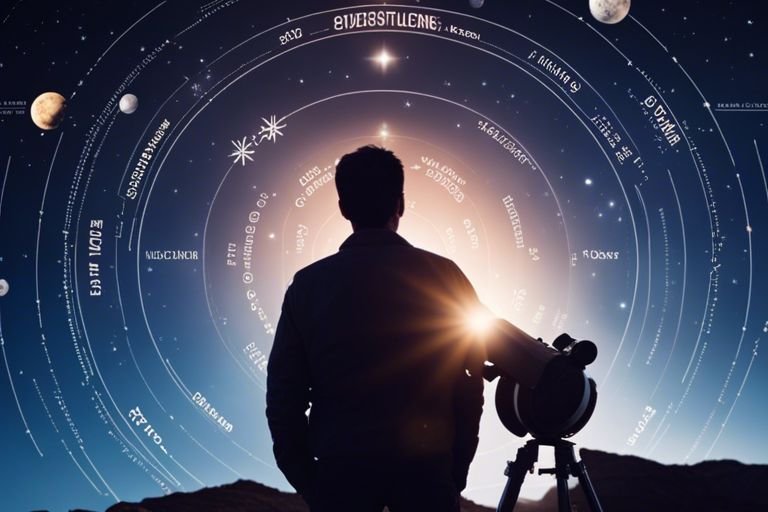Perusing the night sky can be a most exhilarating experience, but it can also be a daunting task to accurately identify the celestial bodies twinkling above us. As an avid stargazer, I have spent countless nights observing the stars and planets, honing my ability to distinguish between them. In this guide, I will share with you some essential tips and tricks for identifying planets in the night sky, allowing you to confidently recognize these fascinating celestial bodies during your own stargazing sessions. Whether you’re a beginner or an experienced astronomer, mastering the art of planet identification will undoubtedly enhance your stargazing experience.
Key Takeaways:
- Understand the celestial bodies: Before stargazing, it’s important to have a basic understanding of the different celestial bodies, such as planets, stars, and galaxies, and their distinguishing features.
- Use star maps and mobile apps: Utilize star maps and mobile apps to identify the location of planets in the night sky, and to track their movement over time.
- Look for planetary motion: Planets in our solar system move against the backdrop of stars, so observing their movement over several nights can help in identifying and tracking them.
- Observe planetary characteristics: Each planet has specific characteristics, such as color, brightness, and apparent size, that can aid in their identification during stargazing sessions.
- Join astronomy groups or clubs: Engaging with astronomy enthusiasts and joining local groups or clubs can provide valuable insights and guidance on identifying planets in the night sky.
Types of Celestial Bodies
Your stargazing sessions will allow you to observe various celestial bodies in the night sky. These include planets, stars, moons, satellites, and other astronomical objects. When identifying these celestial bodies, it is important to understand their characteristics and how they differ from one another.
| Planets | Considered as wandering stars in ancient times, planets are relatively large celestial bodies that orbit around the sun and do not produce their own light. |
| Stars | Stars are massive, luminous spheres of plasma held together by gravity. They emit their own light and are often visible as twinkling points in the night sky. |
| Moons | Moons are natural satellites that orbit around planets. They are visible because they reflect the light of the sun. |
| Satellites | Artificial satellites, such as those launched by humans, can also be observed in the night sky as they orbit the Earth or other celestial bodies. |
| Astronomical Objects | This category includes comets, asteroids, and other celestial phenomena that may be visible during stargazing sessions. |
Differentiating Planets from Stars
When stargazing, it’s important to know how to differentiate between planets and stars. Planets appear to move across the sky, unlike stars which appear to maintain a fixed position. Additionally, planets do not twinkle like stars do due to their proximity and the fact that they reflect light rather than emit it. Look for steady, non-twinkling points of light that are slightly different in color from the stars around them to identify planets in the night sky.
Identifying Moons and Satellites
Moons and satellites can also be observed during stargazing sessions. Moons are natural satellites that orbit planets and can usually be identified by their spherical shape and reflected sunlight. Satellites, on the other hand, appear as moving points of light across the sky and are often visible as they reflect sunlight while orbiting the Earth or other celestial bodies.
Tips for Identifying Planets
If you’re new to stargazing, figuring out which celestial bodies are planets can be a bit daunting. I often use a few tips and tricks to make the identification process easier. Here are some of my strategies:
- Use a Star Chart: Having a star chart or map of the night sky can be incredibly helpful in identifying planets. Look for bright, non-twinkling points of light, as they are likely to be planets.
- Know the Planet Positions: Understanding the current positions of the planets in the night sky is crucial. Research the positions of the planets before heading out for a stargazing session.
- Consider Planet Visibility: Not all planets are visible at the same time. Knowing the best times to observe certain planets can increase your chances of spotting them.
The more I stargaze, the easier it becomes to identify the planets. Practice and consistency are key when learning to recognize celestial bodies in the night sky.
Using Stargazing Apps
If you’re a beginner, using stargazing apps on your smartphone or tablet can significantly enhance your stargazing experience. These apps often provide real-time information about the positions of planets and other celestial bodies in the sky. Some apps even offer augmented reality features, allowing you to point your device at the sky and see an overlay of the constellations and planets. This can be incredibly useful for identifying and understanding the layout of the night sky.
Understanding the Movement of Planets
While stars appear to maintain their relative positions to one another, planets move across the sky. Understanding the movement of planets is important for identifying them. Planets generally move in a predictable manner against the backdrop of stars and constellations. Observing and familiarizing yourself with this movement will greatly improve your ability to identify planets during stargazing sessions.
Step-by-Step Guide to Recognizing Planets
Now that you have familiarized yourself with the night sky, let’s delve into how to identify planets. Not all celestial bodies in the night sky are planets; some may be stars, moons, or even satellites. Therefore, it is crucial to know the distinct characteristics of each planet to accurately recognise them during your stargazing sessions.
| Step | Description |
|---|---|
| 1 | Consult a star map or mobile app to determine the current position of the planets in the night sky |
| 2 | Look for steady, non-twinkling lights, as planets do not flicker like stars |
| 3 | Notice the color of the planet; Venus appears bright white, while Mars has a reddish tint |
| 4 | Observe the movement of the celestial body; planets will slowly change position in the sky over time |
Observing the Night Sky
When observing the night sky, it is important to find a location away from city lights and light pollution to get a clearer view. I recommend setting up a comfortable seating arrangement and allowing your eyes to adjust to the darkness for at least 15 minutes before beginning your stargazing session. Once your eyes have adapted, you will be able to see more stars and celestial bodies with greater clarity.
Using Telescopes and Binoculars
If you want to get a closer look at the planets, using telescopes or binoculars can enhance your stargazing experience. Telescopes allow you to see details such as the rings of Saturn or the moons of Jupiter, while binoculars can provide a clearer view of the planets’ features. Remember to carefully align and focus your equipment to get the best possible view.
Factors Affecting Planet Visibility
Unlike stars, planets have different visibility patterns that are influenced by various factors. Understanding these factors can help you make the most out of your stargazing sessions. Here are some key factors that affect the visibility of planets in the night sky:
- Time of year and location
- Weather conditions and light pollution
- Time of night
- Atmospheric conditions
This understanding can significantly impact the success of your stargazing sessions and your ability to identify planets in the night sky.
Time of Year and Location
The visibility of planets in the night sky can vary depending on the time of year and your location. Certain planets may be more visible at specific times of the year, while others may not be visible at all. Additionally, your geographical location plays a crucial role in determining which planets are visible to you at a given time. Factors such as the tilt of the Earth, the planet’s orbit, and its position relative to the Sun can all influence its visibility.
Weather Conditions and Light Pollution
Another important factor that affects the visibility of planets during stargazing sessions is the weather conditions and light pollution in your area. Clear skies are essential for optimal stargazing, as clouds and atmospheric disturbances can obstruct your view of the planets. Light pollution from urban areas can also diminish the visibility of celestial bodies. It is important to choose a location with minimal light pollution and to check the weather forecast before embarking on a stargazing session.
Pros and Cons of Identifying Planets
Keep in mind that there are both benefits and challenges when it comes to identifying planets in the night sky. Let’s break down the pros and cons of recognizing celestial bodies during stargazing sessions in the table below:
| Pros | Cons |
| Enhances stargazing experience | Difficulty in identifying distant planets |
| Increases knowledge of astronomy | Challenges in differentiating planets from stars |
| Opportunity to observe planetary features | Dependence on weather conditions for clear view |
| Provides sense of wonder and awe | Requires patience and persistence |
| Engages and educates others in stargazing groups | Competing with city lights and light pollution |
| Contributes to personal fulfillment and satisfaction | Time and location constraints for visibility |
| Opportunity for photography and documentation | Equipment and technical knowledge required |
| Connection to ancient traditions and mythology | Impact of celestial events on viewing experience |
Benefits of Planet Recognition
One of the key benefits of identifying planets in the night sky is the enhanced stargazing experience it provides. When you are able to recognize specific celestial bodies, it adds a new level of excitement and wonder to your nighttime observations. It also increases your knowledge of astronomy and allows you to share that knowledge with others, contributing to a deeper appreciation of the cosmos. Furthermore, observing planetary features through a telescope or binoculars can be truly awe-inspiring and fulfilling.
Challenges and Limitations
On the flip side, there are challenges and limitations when it comes to identifying planets in the night sky. One of the main challenges is the difficulty in differentiating distant planets from stars, especially for beginners. Additionally, weather conditions and light pollution can impact visibility, and it requires patience, persistence, and technical knowledge. However, overcoming these challenges can lead to a rewarding stargazing experience.

Conclusion
Upon reflecting on the various techniques and tips for identifying planets in the night sky, I hope that you feel more equipped and confident in recognizing celestial bodies during your stargazing sessions. By familiarizing yourself with the different characteristics of each planet, utilizing star charts, and utilizing digital tools and apps, you can enhance your overall stargazing experience and truly appreciate the beauty of the night sky. Remember to practice patience and be mindful of your surroundings to fully immerse yourself in the wonders of the cosmos.
FAQ
Q: What are the key factors to consider when identifying planets in the night sky?
A: When identifying planets in the night sky, it’s important to consider the time of year, the location, and the brightness of the celestial bodies. Additionally, understanding the movement of the planets and their positions relative to constellations is essential for accurate identification.
Q: Which planets are visible to the naked eye during stargazing sessions?
A: The five planets visible to the naked eye are Mercury, Venus, Mars, Jupiter, and Saturn. These planets are often mistaken for stars due to their bright appearance, but their steady movement across the sky sets them apart from stars.
Q: How can I differentiate between a planet and a star in the night sky?
A: Planets typically have a steady, non-twinkling appearance, whereas stars twinkle due to the Earth’s atmosphere. Additionally, planets exhibit a gradual movement across the sky, as opposed to the fixed position of stars. Using a star map or a stargazing app can also help in distinguishing between the two.
Q: What are some tools or resources that can aid in identifying planets during stargazing sessions?
A: Utilizing a telescope or binoculars can enhance the viewing experience and allow for closer observation of planetary features. In addition, stargazing apps such as SkyView or Star Walk provide real-time information on the positions of planets and other celestial bodies in the night sky.
Q: Are there specific times of the year when certain planets are more visible in the night sky?
A: Yes, the visibility of planets varies throughout the year due to their orbits and the Earth’s position in relation to them. For example, Mars is often at its brightest during opposition, when it is directly opposite the Sun in the sky. Understanding the planetary positions and their respective oppositions can greatly aid in identifying and observing planets during stargazing sessions.









